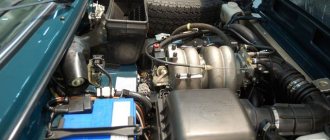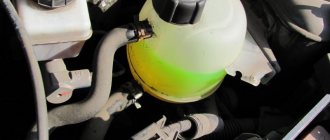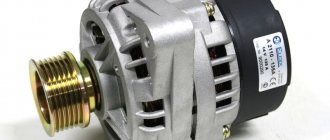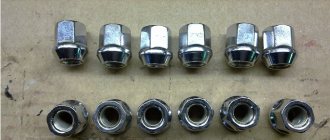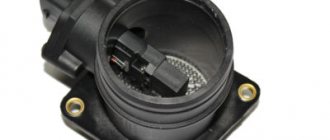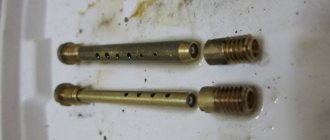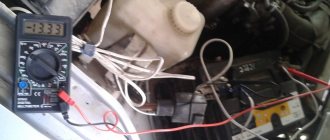Most car owners, when buying a battery, focus only on such an indicator as its capacity, completely ignoring the parameter designated as “starting current”.
And completely in vain! If the “starting parameters” of the battery are selected incorrectly, it is likely to last much less than the declared resource, and already in the first winter you will experience difficulties starting the power unit in cold weather.
A few words about the structure and properties
Batteries were created specifically to recharge and start the car, that is, they are very practical from the point of view of operation. A regular battery discharged very quickly, and it was expensive to change it; that’s when batteries were invented.
Through trial and error, batteries evolved - so a few years after the invention, a very specific model emerged, this was about 100 years ago, which has not changed until now.
Usually these are six compartments with plates made of lead (negative) and its oxide (positive), which are filled with a special electrolyte made of sulfuric acid. It is this combination that makes the battery work; if one component is excluded, the operation will be disrupted. One scattered battery generates an average of 2.1V, this is extremely little to start the engine; in an average battery, they are combined by connecting them in series, usually 6 banks of 2.1V = 12.6 - 12.7V. This voltage is enough to excite the starter winding.
A few words about capacity
However, voltage is only one of the components; it is unified, that is, it is the same for all batteries, regardless of capacity.
But the capacity can differ significantly. It is measured in Amperes per hour, or simply Ah. If we derive a small definition, then this is the ability of a battery to deliver a certain amount of current for an entire hour. Automotive options start at 40 Ah and go up to 150 Ah. However, the most common ones on ordinary foreign cars are 55 – 60 Ah. That is, the battery can deliver 60 Amps for an hour, and then it will be completely discharged. To be honest, this is a big value, if you multiply 12.7 (voltage) and 60 Ah (capacity), you get 762 Watts per hour! You can warm up the electric kettle a couple of times.
We also sorted out the capacitance, now let’s talk directly about the starting current.
Battery selection
A car battery has many characteristics that need to be taken into account when choosing a new battery:
- Capacity. This value is expressed in Ah and reflects the maximum operating time of a fully charged battery. The choice based on it consists of comparing it with the car’s passport or the old standard battery model. The capacity is also selected according to the volume of the internal combustion engine. For example, to start engines up to 1.7 liters, it is enough to install a 55-60 A/h battery. If you have installed additional lighting or a fancy audio amplifier, we recommend a battery with a large parameter, but within the geometric dimensions. Since a more energy-intensive battery will have increased dimensions.
- Polarity. The location of the terminals determines the physical possibility of installing the battery in its original location and connecting the cables. For European cars, they usually buy batteries with direct polarity, for Russian cars - with reverse polarity, and for Asian cars they produce both. There are also universal ones, in which the terminals are located in the middle of the housing.
- Starting current. When you and I choose a battery and put it first, this is wrong. It is necessary to take into account the region and climatic conditions where the machine will be operated. If these are moderate latitudes with a normal climate, then there is no point in overpaying for more amps in the battery. If you need a frost-resistant source, the more amperes it has, the better, but the service life will be significantly shorter. We remind you that the inrush currents measured by different standards are different.
The table compares the characteristics of batteries of different performance standards:
| SAE/CCA | EN | IEC | DIN |
| 350 | 330 | 225 | 200 |
| 400 | 360 | 260 | 225 |
| 450 | 420 | 290 | 255 |
| 500 | 480 | 325 | 280 |
| 550 | 520 | 355 | 310 |
| 600 | 540 | 390 | 335 |
So what is this inrush current?
As I already wrote above, the starting current is the maximum current that the battery can deliver in a very short period of time. In simple words, to start the engine of an average car you need approximately 255 - 270 Amperes, a lot! In essence, these are “starting values”, from the word “start” in relation to the power unit.
If the battery capacity is approximately 60 Ah, then this exceeds its nominal value by approximately 4 - 5 times. True, such tension should only be given for about 30 seconds, no more.
Often in the southern regions of our country, where the air temperature always remains in the positive zone, this parameter is not even considered! Because no matter what, we take an average battery, and it will cope with its duties perfectly. After all, it’s warm outside and the oil is liquid. But in the northern regions this indicator is one of the most important, where temperatures are often in the extremely negative zone and it is difficult to start the power unit; the oil looks more like jelly than a flowing liquid. The launch will be extremely difficult.
If to start the engine at “+ 1 + 5” degrees, 200 - 220 Amperes will be enough (at one time), then to start it already at - 10 - 15 degrees, you need to spend 30% more energy, and this is 260 - 270 Amps. Now think about how much energy is wasted at -20 - 30 degrees Celsius.
Thus, the lower the temperature in winter, the more important this parameter is, this is a kind of axiom.
Methods for checking PT
Can you trust the numbers provided by the manufacturer? It's a purely individual matter. Batteries from lesser known brands are really worth researching. But how can you check the starting current of the battery yourself, because, as we found out, this characteristic is very important?
There are several ways to do this using “folk” methods, but, let’s be honest, all of them are not highly accurate - for this you need to use expensive professional equipment.
A multimeter is not suitable for these purposes, and you will not find a description online of how to measure the starting current of a battery with such a device. The fact is that the multimeter is not designed to measure current ratings of several hundred amperes - if there are separate models that are able to do this, they will be too expensive.
So you will have to use less accurate methods:
- using a load fork, which is a voltmeter equipped with an additional resistance. The load plug, when connected to the battery terminals, acts as a load, replacing the on-board network of the machine;
- current clamps. This is the most affordable device for measuring the starting current of a car battery; it is not afraid of large amperages;
- The “grandfather” test consists of turning on the low beam on the car. If the brightness of the lamp does not change for 5-10 minutes, we can say that the battery is working. In this way, you can cut off a known problem battery when purchasing it;
- The “hearing” test is basically carried out every time we start the car. If the fuel system is in good condition, the engine should start in 2-4 seconds. When it takes more than 10 seconds, we can say that its starting current is insufficient.
What does the starting current depend on?
If you look at different manufacturers, for example European countries, the USA, Russia or China, then all these batteries will have a different inrush current. So, for example, if you compare 55 Ah China and Europe, the difference can be 30 - 40%! But why is that?
It's all about technology:
- The use of purified lead, even in simple acid batteries, will lead to rapid charging and subsequent discharging, and accordingly the starting values will increase.
- A larger number of plates in a body of the same dimensions.
- More electrolyte.
- The plus plates are more porous, which will allow more charge to accumulate.
- Hermetic designs do not allow the electrolyte to evaporate, which will allow the battery to always maintain the desired level without exposing the plates.
Of course, you can add build quality and integrity of the manufacturer, all this gives better results than competitors. It’s true that such batteries are more expensive.
But at the moment, there are also new technologies - the record holders for starting current output are GEL and AGM batteries , their output current can reach up to 1000 Amperes in 30 seconds, about 3 - 4 times more than conventional acid options. Although these technologies also have their disadvantages, and first of all this is the price.
It is also worth noting that when starting the engine, the battery voltage drops to approximately 9 Volts, but the current increases many times - this is a normal process. After starting the engine, the voltage will return to its normal level of 12.7 Volts, and the spent charge will be replenished by the car’s generator. If the voltage readings during startup drop to 6 Volts (and take a very long time to recover), then this can be critical; the starter simply does not have enough energy to start. Most likely the battery is failing.
Causes of starting power
Considering different battery manufacturers from Europe, the USA, China and Russia, we can conclude that they all produce batteries with different starting current strengths. For example, batteries with a capacity of 60 amperes per hour may differ in this value by 35-45%.
It depends on the production technology:
- Using purified lead for production will lead to faster charging and discharging of the battery and, accordingly, will increase starting power.
- The body dimensions are the same, but the number of lead plates in them is different.
- The volumes of electrolyte in such batteries differ.
- Plus plates have more pores, allowing more charge to be stored.
- Thanks to a more hermetically sealed housing, the electrolyte does not evaporate and always fills the plates.
In addition, you can add the quality of production and the integrity of the manufacturer. All of these factors influence the inrush current results. But, on the other hand, their price is much higher than that of their competitors.
Today there are more powerful technologies that allow you to get a current of 1000 amperes in 30 seconds. Among the leaders are batteries such as GEL and AGM. Although their significant disadvantage can be considered their very high price.
In addition, it should be noted that when the engine starts and voltage is applied to the starter, the voltage drops to approximately 9 volts, but the cold current increases greatly. This process is how it should happen and is considered normal. After starting, the voltage increases again to the usual 12.7 volts, and the lack of energy spent at start is compensated by the car’s generator.
In the case when the voltage drops to 6 volts and takes a very long time to recover, most likely the battery is faulty and needs to be replaced.
How are measurements taken?
After the battery is produced, it must be tested to determine the starter voltage. Tests in production are complex; batteries are often placed in subzero temperatures, cooled for several hours, and then tried to start the engine.
Usually the tests take place at -18 degrees Celsius and the start-up lasts 30 seconds; if the battery copes, then it can be put into production. If not, change the design, filling, and carry out tests on a new one.
They measure several times, that is, there are a number of intervals with maximum values, during such intervals the maximum currents that this particular instance is capable of producing are measured, they are recorded and later applied to the “sides” of the battery. It should be noted that not all batteries in the batch are tested so strictly. However, “defects” are present, and checks are carried out with a load fork.
In fairness, it is worth noting that earlier in Soviet times, batteries were not filled with electrolyte at all in production (there was a concept of a dry charge), you yourself had to fill and charge them! That is, we buy an electrolyte of the required density, and then charge it for 12 – 24 hours.
Device test
After the battery is produced and leaves the production line, it needs to be tested and the starter parameters determined. It is quite difficult to test them in factory conditions. First, they are placed in sub-zero temperatures for several hours, and then they try to start the engine.
Typically, such tests are carried out at 18 degrees Celsius below zero and last 30 seconds. If the battery has withstood such a load, it can be put into mass production. Otherwise, the already improved battery is retested with new filling and design indicators.
Measurements are taken several times at certain intervals. They show the maximum value of the starter current. It is indicated on the battery itself. At the same time, not all copies in the batch are tested, so there are cases of defects.
It is worth noting that in Soviet times there was the concept of a dry charge. That is, we bought a battery without electrolyte. Then such a substance was purchased separately in the required density, filled in independently, and the battery was charged throughout the day.
What is the starting current of an average battery and what should I do if I buy a larger value?
At the moment there is a division of starting values into gasoline and diesel units. After all, a diesel engine initially needs a higher indicator, because its compression ratio is much higher, can reach up to 20 atmospheres.
SO, the averages:
For gasoline options this is 255 Amperes
For diesel options - at least 300 Amperes
These figures, as they say, were measured at minus 18 degrees Celsius, which may not be enough when starting in severe frosts.
But now, with the development of technology, we can often see starter current indicators in stores of 400, 500 and even 600 Amperes! What happens if you take these numbers? Am I burning my starter?
The answer is simple - of course not. Don't burn it! Take it and forget what a cold start is, with such characteristics you won’t care about any frost.
As for the starter, with a higher current, it will rotate faster and stronger, which will allow it to make more revolutions, and in turn this will contribute to a quick and high-quality start of the engine.
Of course, you need to read the characteristics of your car, but I think a starting value of 450 - 500 AMPERES will be enough for all regions of Russia. Again, I’ll make a reservation, I’m now considering ordinary cars, not trucks, with large and high-volume engines; often even 600 will not be enough for them.
Increased battery performance
Today, starting values need to be divided into devices for diesel engines and gasoline engines. Indeed, in diesel engines, the starter voltage indicators are much higher than in gasoline engines, since the compression in the air cylinder is much higher and can reach up to 20 atmospheres.
Therefore, you can focus on averages:
- in gasoline engines 250 atmospheres;
- in diesel engines - 300 atmospheres.
These figures can be relied upon at 18 degrees below zero, which will not be sufficient at all in more severe frosts.
Today in stores you can find batteries with starting power ratings of even 600 amperes. Many people worry about this because they can burn the starter with such voltage. But in this case there is no need to worry. It is impossible to burn the starter in this way, and if possible, it is better to take a more powerful battery and forget about how difficult it is to start in severe frosts.
Everything is clear about the starter here. This will not damage it in any way, but will only increase the speed when starting, which, in turn, will lead to a quick and high-quality start of the engine. Therefore, do not be afraid if the starting current of the battery is higher than the standard one.
Of course, you need to take into account the characteristics of the car, but a starter current of 300-400 amperes will be enough for almost all regions of the country. This applies to passenger cars.
For large machines, 600 amperes will often not be enough.
Classification in the world
As I have already touched on a little, in the world there are now several main classifications of inrush current values. Which have their own identification and labeling methods. To begin with, how are they marked:
- German manufacturers stand out here - they apply the “DIN” marking
- In America they apply “SAE”
- In European Union countries (not Germany) they apply “EN”
- In Russia they often write “starting or starting current”
In any case, if you do not find indicators on the sides or the battery cover, then you need to ask the seller about these values, sometimes they are indicated in the books that come with the battery. Now a couple of words about the determination method:
- In European countries, the battery is cooled to -18 degrees and discharged for 10 seconds to 7.5 Volts.
- The Germans also cool to -18 degrees and discharge to 9 Volts for 30 seconds.
- The Russian methodology is similar to the German one; according to GOST, we have the same discharge values, with which the main indicators are recorded.
- In the USA, at -18 degrees, they discharge to 7.2 Volts within 30 seconds.
Let me explain a little - when the voltage drops, the ampere consumption increases, and this is exactly what is recorded (essentially, simulating a start). Cooling simulates difficult weather conditions.
Now the video version of the article, for those who do not understand, watch it.
I’ll end here, by the way, a very useful article - how to choose a battery , I recommend it to everyone. Read our AUTOBLOG.
Similar news
- Batteries “Europe” and “Asia” - what are they? How to determine and what they...
- Battery bank. What it is? How many are there? What is the voltage
- Gel or acid battery. Which is better? Only facts + B...

